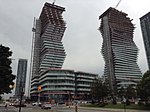Mississauga Celebration Square

Celebration Square is a 290,000 square foot outdoor civic centre, park and amphitheatre located on City Centre Drive in Mississauga, Ontario. The project was first announced to begin construction in 2007 and completed in 2011. The two firms, CS&P architects and Janet Rosenberg + Associates were responsible for the design and construction of the park. The park was commissioned as a demolition and renovation of the two previous ‘library’ and ‘city hall’ squares in the downtown area of Mississauga. The design features an expansive turf grass field with adjacent amphitheatre, a surrounding stone path, benches, canopies and secondary stage. The square's large water feature becomes ice rink in the winter and doubles as an event space when needed. The project is said to juxtoposition small intimate spaces with large open areas of turf. The transformation has dramatically increased the use of the property for daily civic life.
Excerpt from the Wikipedia article Mississauga Celebration Square (License: CC BY-SA 3.0, Authors, Images).Mississauga Celebration Square
Mississauga Celebration Square, Mississauga
Geographical coordinates (GPS) Address Nearby Places Show on map
Geographical coordinates (GPS)
| Latitude | Longitude |
|---|---|
| N 43.5884 ° | E -79.6434 ° |
Address
Mississauga Celebration Square
Mississauga Celebration Square
Mississauga
Ontario, Canada
Open on Google Maps









